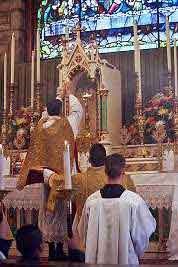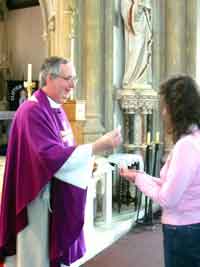|
 
News has been abuzz about the recent disciplinary action
taken by the Congregation of the Religious against the
Franciscan Friars of the Immaculate (FFI), specifically
(and apparently centering upon) the order that their
priests must cease offering the traditional Roman Mass
as of August 12, unless they have individually obtained
special permission.
A general outcry has resulted amongst those of a
traditionalist bent, leading to a wailing and gnashing
of teeth, the former out of worry of what the future
holds for the traditional Roman Mass, and the latter in
anger against the most recent injustice committed
against the venerable rite.
There have been those who are quick to defend the legal
aspects of the matter per Pope Benedict XVI’s
Summorum Pontificum, while also claiming that the
Congregation’s decree is undoing the pope-emeritus’
liturgical reforms. However, the friars have been more
accurate in summarizing the reality of things when they
stated in response to the decree’s objectors: “Francis
has not contradicted Benedict’s reforms”.[1]
Pope Francis is indeed continuing in the way of Pope
Benedict’s “reforms” – for he has yet to correct
the liturgical fallacy latent in the Summorum
Pontificum and Universae Ecclesiae. These
documents did confirm that the traditional Roman Mass
had never been abrogated, but both contain an Achilles
Heel in relation to the New Mass – they ignored that it
is theologically-deficient and was not properly
promulgated.
Thus instead of saying that
in its theology the True Mass is diametrically opposed
to the Novus Ordo, Summorum Pontificum
affirms that they are “one and the same rite”.
Instead of stating that in logical consequence that
Quo Primum was never abrogated – or that the proper
legislation for promulgating the New Mass was lacking –
and thus the Mass of All Ages is still de jure
the liturgical norm and official rite of the Roman
Church, it has been given the legal term of
“extraordinary form”, while the Consilium’s revolution
has been deemed the “ordinary form”.
Hence in consequence of the erroneous legal labels of
“extraordinary” and “ordinary”, the Novus Ordo
Missae continues to be regarded as the liturgical
norm of the Roman Rite, while the Immemorial Mass
takes second place in precedence not only in law, but
more importantly in theology in expressing the Faith.
This latter crucial point has been further compounded by
Universae Ecclesiae, which reiterated the
unacceptable condition of the 1984 Indult, that the
theological orthodoxy of the New Mass must not be called
into question by those desiring the Roman Mass.
This Achilles Heel – that the New Rite is theologically
sound and was properly promulgated and thus has a right
to exist and even supersedes the Tridentine Rite –
becomes even more vulnerable with the addition of a
“Reform of the Reform” mentality; that is, the New Mass
has some issues, but these can be fixed by melding it
with the Old Mass. This denies the reality though that
the Novus Ordo Missae has a deformed nature (an
ecumenical foundation) and thus cannot be reformed.
All of these problems find their synthesis in the term
“extraordinary form”, which implicitly denies the
reality of the theological and canonical status of the
traditional Roman Mass – thus as I have stated in
previous Remnant articles, the essential
fight for our Rite is far from over.
Nor can the battle for the Mass of All Ages be
ultimately won if it is conceded that the Novus Ordo
Missae is the “ordinary form”, is “one and the
same rite” with the traditional Roman Mass, and is a
legitimate theological expression of the Catholic Faith
– because as Michael Davies once wrote: “Let it be
made clear once and for all, opposition to the new Mass
is based on theological and not cultural considerations…”.[2]
Thus the battleground must be first and foremost on the
doctrinal plane and not on the grounds of accidentals or
esthetics (after all, beauty is the expression of
Truth).[3]
As for those currently itching to make legal arguments
for the FFI and the traditional Mass, while these are
certainly important, we must face the fact that
ecclesiastical laws will only be applied as much as the
seated judge sees fit – and as has been frequently
witnessed during the post-conciliar era, those laws that
support Tradition are generally struck down, obfuscated
or circumvented by the liberal-controlled Curia, and not
held up. Consider the illegal actions taken against
Archbishop Lefebvre and his Society of St. Pius X
between 1974 and 1975 – even to the point that his right
to an ecclesiastical trial was (via political
machinations) unjustly denied, causing His Excellency to
famously quip: “even the Communists would at least
grant you a kangaroo trial!”[4]
In conclusion, it must be recognized that “it’s the
Mass that matters” because it is the most visible
aspect of our struggle against Modernism and to restore
the Catholic Faith, whole and entire. So while the True
Mass is certainly our banner in this supernatural
conflict, it is not the war in itself. Holding to this
complete position will not win any popularity contest in
the mainstream Church, even amongst many attracted to
the traditional Mass, but it is the only real way in
which complete victory will finally be obtained, for the
salvation of souls and glory of God.
Footnotes
1 Extracted from the title of June 31st article
published by the National Catholic Register, “Francis
Has Not Contradicted Benedict’s Reforms, Say Franciscans
of the Immaculate”.
2 The New Mass (Augustine Pamphlets, 1977).
3 To this end, there are many excellent books available
from Angelus Press that deal specifically with the
issues of the Church crisis and the errors of Modernism,
as well as the Novus Ordo Missae, such as: The
Mass of All Time, Pope Paul’s New Mass and
The Roman Rite Destroyed
4. Cf. the book, Archbishop Lefebvre and the
Vatican and Marcel Lefebvre: A Biography for
details. |
